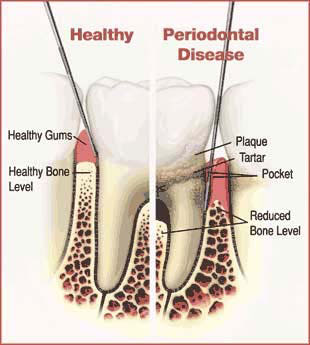Periodontal Disease
 The word periodontal means “around the tooth.” Periodontal disease is a infection that affects the gums and bone surrounding the teeth. A periodontal infection can affect many teeth. The infection process begins when bacteria are allowed to accumulate on the teeth. A “sticky” matrix termed plaque is formed from the accumulation of bacteria. If plaque is left undisturbed, it will eventually form calculus, or “tartar” which provides a rough surface for even more bacteria to accumulate. This causes the gum tissue to become infected. If the bacteria remains, then infection migrates into the bone and becomes a “bone level infection” If periodontal disease is left untreated, it can eventually lead to tooth loss.
The word periodontal means “around the tooth.” Periodontal disease is a infection that affects the gums and bone surrounding the teeth. A periodontal infection can affect many teeth. The infection process begins when bacteria are allowed to accumulate on the teeth. A “sticky” matrix termed plaque is formed from the accumulation of bacteria. If plaque is left undisturbed, it will eventually form calculus, or “tartar” which provides a rough surface for even more bacteria to accumulate. This causes the gum tissue to become infected. If the bacteria remains, then infection migrates into the bone and becomes a “bone level infection” If periodontal disease is left untreated, it can eventually lead to tooth loss.
The gum tissue forms a collar around your teeth. The gums attach to the tooth, just above the bone level. The distance from the top of the collar to the attachment level makes a “pocket” next to the tooth. As the gums become infected, the pockets begin to deepen. When the pockets deepen further, this is an indication that the infection is progressing into the bone. When the infection reaches the bone, it destroys the bone surrounding your teeth. Eventually, enough bone is destroyed were the teeth become loose and have to be removed.
At the initial examination, the probing depths are recorded on a chart. The chart consists of the teeth that are present, the pocket depth recordings, areas of bleeding and pus, tooth mobility and other tooth factors. This shows areas that are infected that need to be treated. Probing depths of 6 mm or greater generally indicate the infection has gone into the jawbone.
Self-Evaluation Quiz
You may not realize that persistent swollen, red or bleeding gums, tooth sensitivity, and bad breath are warning signs of periodontal (gum) disease. Take this self evaluation quiz from the American Academy of Periodontology to determine if you have some of the symptoms of periodontal disease.
- Do your gums ever bleed when you brush your teeth or when you eat hard food?
- Have you noticed any spaces developing between your teeth?
- Do your gums ever feel swollen or tender?
- Have you noticed that your gums are receding (pulling back from your teeth) or your teeth appear longer than before?
- Do you have persistent bad breath?
- Have you noticed pus between your teeth and gums? Or do you have a bad taste in your mouth?
- Have you noticed any change in the way your teeth fit together when you bite?
If you answered yes to any of these questions, you may want to visit the Periodontist.
